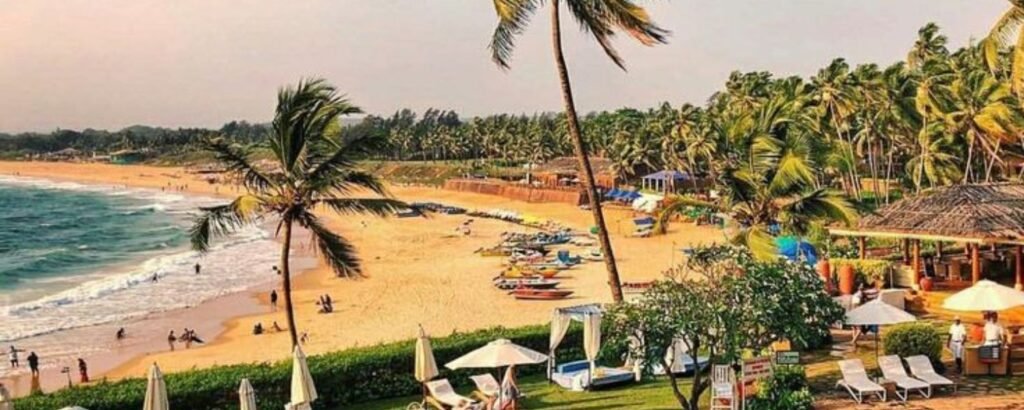Introduction
Goa. Just the name conjures images of sun-kissed beaches, vibrant nightlife, and a laid-back, carefree vibe. It’s a place that draws travelers from all over the world, promising a unique blend of Indian and Portuguese cultures. But beyond the popular tourist attractions, Goa holds a treasure trove of fascinating secrets and surprising facts.
This blog will dive deep into the heart of Goa, revealing some amazing facts about Goa that might just make you pack your bags and head straight for its shores. We’ll explore everything from its lush forests and rich history to its unique wildlife and cultural quirks, uncovering interesting facts about Goa that will leave you amazed.
Over a third of Goa is covered by forest
When you think of Goa, beaches and parties likely come to mind. However, did you know that dense, verdant forests cover over a third of this tiny state? This surprising fact reveals a side of Goa that many often overlook.
The Western Ghats, a UNESCO World Heritage Site, run through Goa, providing a haven for diverse flora and fauna. These forests are home to a variety of wildlife, including leopards, wild boars, and a plethora of bird species.
This unknown fact about Goa highlights the state’s commitment to preserving its natural beauty, offering visitors the chance to explore its wild side through trekking and nature walks.
Goa is India’s smallest state
Despite its immense popularity and global recognition, Goa is actually India’s smallest state by area. It covers a mere 3,702 square kilometers, making it easy to explore in a relatively short period.
This small size, however, doesn’t diminish its impact. Goa packs a punch with its diverse attractions, from its stunning coastlines to its historical landmarks. This important fact about Goa explains why it’s so easy to navigate and experience a wide range of activities within a limited timeframe.
Goa has the highest per capita income in India
Another surprising fun fact about Goa is that it boasts India’s highest per capita income, driven by its thriving tourism, mining, and fishing sectors.
The state’s relatively small population and robust economy boost its high standard of living. This economic strength reflects in the well-maintained infrastructure and the overall quality of life its residents enjoy.
Portugal ruled Goa for almost 450 years
Goa’s history is deeply intertwined with Portuguese rule. For nearly 450 years, from 1510 to 1961, Goa was a Portuguese colony. This long period of foreign influence has left an indelible mark on the state’s culture, architecture, and cuisine.
You can see this influence in the beautiful churches, old Portuguese houses, and the unique blend of Indian and Portuguese flavors in Goan food. This historical fact about Goa is crucial to understanding the state’s unique character and its distinct identity.
Goa celebrates two independence days
This is one of the more unique facts about Goa. While India gained independence from British rule on August 15, 1947, Goa remained under Portuguese control until December 19, 1961.
This day, Goa Liberation Day, marks the end of Portuguese rule and is celebrated as Goa’s second independence day. This dual celebration highlights the state’s unique historical journey and its distinct path to freedom.
Over 400 species of birds have made Goa their home
For brdwatching enthusiasts, Goa is a paradise. With over 400 species of birds recorded in the state, it’s a haven for avian diversity. The Bhagwan Mahaveer Sanctuary and Mollem National Park are prime locations for birdwatching, offering the chance to spot rare and exotic birds like the Malabar Pied Hornbill, the Sri Lanka
Frogmouth, and the Ruby-throated Bulbul. This amazing fact about Goa showcases the state’s rich biodiversity and its commitment to preserving its natural habitats.
Goa has one of India’s largest waterfalls
Dudhsagar Falls, meaning “Sea of Milk,” is one of India’s tallest waterfalls and a major attraction in Goa. Cascading down from a height of 310 meters, the waterfall creates a mesmerizing spectacle, especially during the monsoon season when it’s at its fullest. The waterfall is located within the Bhagwan Mahaveer Sanctuary and Mollem National Park, offering a scenic trek through lush forests. This interesting fact about Goa highlights the state’s natural beauty and diverse landscapes.
Some of India’s oldest rocks are found here
Geologically, Goa is a treasure trove of ancient history. Some of the oldest rocks in India, dating back billions of years, are found in Goa. These rocks provide valuable insights into the Earth’s geological past and are a testament to the region’s long and complex history. This unknown fact about Goa adds depth to the state’s natural wonders, showcasing its geological significance.
Can you guess how many bars Goa has?
Goa’s nightlife is legendary, and it’s no surprise that the state has a staggering number of bars and pubs. While an exact number is hard to pin down, it’s safe to say that Goa has a disproportionately high concentration of bars compared to other Indian states. From beach shacks serving chilled beers to trendy nightclubs with live music, Goa offers diverse options for those looking to unwind and enjoy the nightlife. This fun fact about Goa underscores the state’s reputation as a party destination.
The Non-Decomposing Body, St. Francis Xavier
One of the most remarkable and somewhat macabre historical facts about Goa is the presence of the incorrupt body of St. Francis Xavier at the Basilica of Bom Jesus in Old Goa. The body, which has been preserved for over 400 years, is displayed to the public every ten years, drawing pilgrims from around the world. This phenomenon has been attributed to divine intervention by many, adding to the mystique and religious significance of Goa.
Asia’s Only Naval Aviation Museum is in Goa
The Naval Aviation Museum in Bogmalo, Goa, stands as a unique testament to India’s maritime air power, being Asia’s sole museum dedicated to this specialized field. It offers a captivating journey through the evolution of Indian naval aviation, showcasing a remarkable collection of retired aircraft, helicopters, and armaments.
South Goa Beaches are a perfect blend of serene beauty and coastal charm, offering visitors peaceful escapes with pristine shores and crystal-clear waters. Beyond the beaches, visitors are treated to a close-up look at iconic machines like the Sea Harrier, Alizé, and various helicopters at the Naval Aviation Museum.
Each aircraft has its own story of service and innovation, contributing to India’s maritime history. The museum meticulously documents the challenges and triumphs of naval aviators, highlighting their crucial role in safeguarding India’s vast coastline and maritime interests. Whether relaxing on the tranquil beaches or exploring the museum, South Goa presents an enriching experience for all types of travelers.
Through detailed exhibits and informative displays, it illuminates the strategic importance of naval aviation, providing insights into its operational capabilities and its contributions to national security.
The Goa State Museum is a living history lesson, showcasing Goa’s rich history, culture, and military heritage through a diverse collection of artifacts, sculptures, and memorabilia.
Goa Remembers Its History
Old Goa, a UNESCO World Heritage Site, is a living museum, preserving the echoes of its colonial past. As one of the most significant Heritage Sites in Goa, it offers a glimpse into the region’s rich history. The grandeur of the Se Cathedral, with its towering facade and intricate interiors, speaks of centuries of religious devotion.
Nearby, the Church of St. Francis of Assisi showcases a blend of Manueline and Baroque styles, its walls adorned with exquisite frescoes. The Basilica of Bom Jesus, housing the preserved remains of St. Francis Xavier, stands as a testament to the enduring influence of Christianity in Goa.
These architectural gems, along with numerous other churches and convents, are not merely relics of the past; they are vibrant reminders of Goa’s unique historical trajectory.
They tell stories of Portuguese explorers, missionaries, and settlers, and the complex interplay between European and Indian cultures. Wandering through Old Goa is like stepping back in time, allowing visitors to witness the tangible legacy of a bygone era and to appreciate the rich tapestry of Goa’s heritage.
Conclusion
Goa is more than just a beach destination. It’s a land of contrasts, where ancient history meets modern vibrancy and lush forests meet sun-drenched shores. From its unique cultural blend to its rich biodiversity, Goa offers many experiences that cater to every traveler.
Goa isn’t just known for its beaches and vibrant nightlife; it’s also a haven for adventure sports in Goa. From thrilling water sports like parasailing, jet skiing, and windsurfing to off-road biking and trekking, Goa offers a variety of adrenaline-pumping activities for adventure enthusiasts.
These amazing facts about Goa reveal the depth and complexity of this fascinating state, showcasing its hidden gems and highlighting its unique charm. Whether you’re interested in exploring its historical landmarks, immersing yourself in its natural beauty, or simply relaxing on its pristine beaches, Goa has something to offer everyone. So, the next time you’re planning a vacation, consider Goa – a place where every corner holds a discovery.
FAQ
Q: What are some interesting facts about Goa beaches?
A: Goa beaches are known for their diversity. Some, like Baga and Calangute, are bustling with activity and nightlife, while others, like Palolem and Agonda, offer a more serene atmosphere. Many beaches are also home to unique rock formations and diverse marine life.
Q: What are some fun facts about Goa’s culture?
A: Goa’s culture is a blend of Indian and Portuguese influences. This is evident in its architecture, cuisine, and festivals. Goa is also known for its vibrant music and traditions, including the Kunbi and Dekhni dance.
Q: What are some historical facts about Goa?
A: Goa was a Portuguese colony for nearly 450 years, from 1510 to 1961. This long period of foreign rule has left a significant impact on the state’s culture and architecture. Goa also celebrates two independence days, one for India’s independence and another for Goa’s liberation from Portuguese rule.
Q: What are some unknown facts about Goa’s wildlife?
A: Over a third of Goa is covered in forests, providing a habitat for diverse wildlife, including leopards, wild boars, and over 400 species of birds. Goa is also home to Dudhsagar Falls, one of India’s tallest waterfalls, and some of India’s oldest rocks.
Q: What are the airports in Goa?
A: Goa is well-connected with the world through its Airports in Goa. The primary international gateway, Dabolim Airport (GOI), serves both domestic and international flights. Additionally, the newly opened Manohar International Airport (GOX) in Mopa, North Goa, further enhances the state’s connectivity, making it even more accessible for travelers worldwide.










